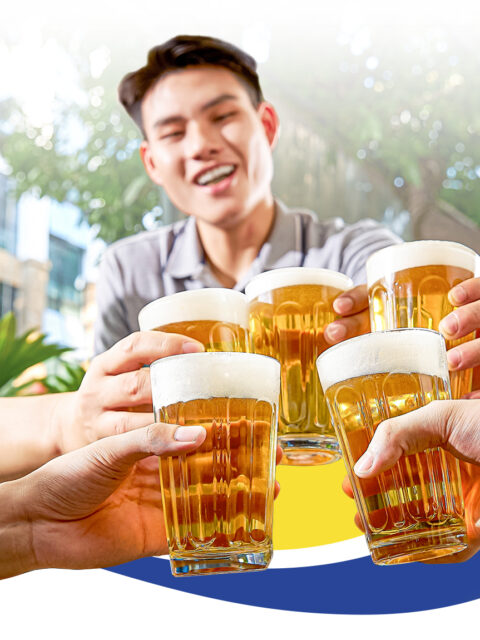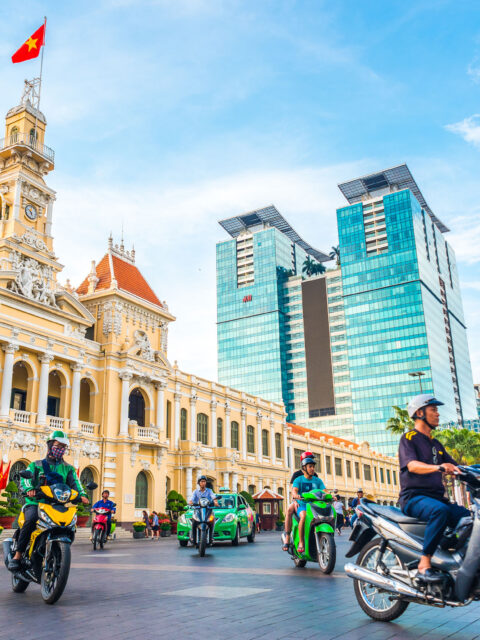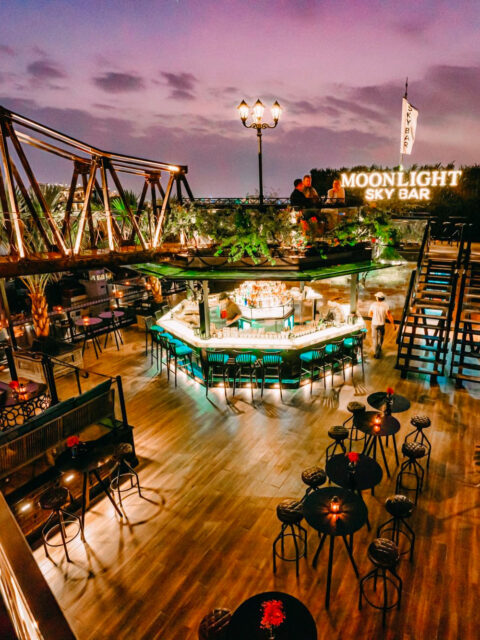Vietnam, a land of breathtaking natural beauty and vibrant cultural diversity, beckons travelers from around the world to explore its traditions deeply rooted in history and heritage. Beyond the bustling cities, picturesque landscapes, and delectable cuisine, Vietnam’s traditions are an integral part of the country’s identity.
Understanding these traditions not only enhances the travel experience but also fosters cultural appreciation and respect, allowing visitors to forge meaningful connections with the local people.
This article aims to offer an insightful journey into the heart of Vietnamese culture and heritage, providing tourists with a deeper understanding of the rich tapestry that makes up this Southeast Asian nation.
Discover the best time to visit Vietnam to plan your next perfect trip!
Plan your hassle-free trip to Vietnam with e-Visa!
Let our extensive 10+ years of experience in visa services be your guiding light as you book with us, guaranteeing a smooth and worry-free trip to Vietnam!



Contents
History of Vietnam
Vietnam’s rich history has played a pivotal role in shaping its vibrant traditions and culture. It all begins with the ancient origins of Vietnam, tracing back to the legendary Hong Bang Dynasty. These early roots were influenced by neighboring cultures, such as Chinese culture and India, introducing elements that would lay the foundation for Vietnam’s customs. However, it was during the period of Chinese domination that Vietnam underwent significant cultural assimilation. This era, lasting for over a thousand years, introduced Confucianism, Buddhism, and the Chinese writing system to Vietnam, leaving indelible imprints on its traditions.
As Vietnam moved towards independence and dynastic rule, notable dynasties like the Ly, Tran, Le, and Nguyen contributed to the development of distinct Vietnamese customs, art, and governance. These dynasties left behind a rich legacy that still influences Vietnamese society today. Subsequently, the colonial era under French rule brought about a clash of Western culture and traditional values. French architecture, cuisine, and education left an enduring mark on Vietnamese culture, reflecting the complexities of cultural fusion.
The 20th century was marked by pivotal moments in Vietnam’s history, including its struggle for independence against French colonialists and the Vietnam War. These events shaped Vietnam’s contemporary identity, fostering a spirit of resilience and determination among Vietnamese people. In the post-war period, Vietnam embarked on a path of cultural revival and nation-building, with government policies and the entire country’s effort to aimed at preserving and promoting Vietnamese traditions.
Today, as Vietnam embraces globalization and modernization, it continues to honor the country’s rich cultural heritage while adapting to the demands of the 21st century, resulting in a unique blend of ancient customs and contemporary influences.

Festivals in Vietnam
Vietnam boasts a tapestry of culturally rich festivals, offering a captivating glimpse into its traditions and way of life. Let’s delve into some of the most significant ones!
Discover the top things to do in Vietnam with our guide!
Tet Nguyen Dan (Lunar New Year)
Tet, celebrated as the Lunar New Year, takes the crown as Vietnam’s most revered and important festival. Falling in late January or early February based on the lunar calendar, Tet marks the arrival of spring. Families meticulously clean and adorn their homes, pay homage to ancestors, exchange gifts, and savor traditional foods. At its heart, Tet signifies family reunions, the strengthening of familial bonds, and wishes for prosperity in the coming year.

Mid-Autumn Festival (Tet Trung Thu)
Held in September, the Mid-Autumn Festival holds a special place in the hearts of Vietnamese families and children. The festival revolves around mooncakes, traditional lanterns, vibrant parades, the reunion of family members, and the exuberant performances of lion dances. It’s a time to appreciate the harvest, cherish the company of loved ones, and pay homage to age-old legends associated with the moon.
For a fulfilling Mid-Autumn Festival experience, you can come to bustling cities like Hanoi or Ho Chi Minh City.
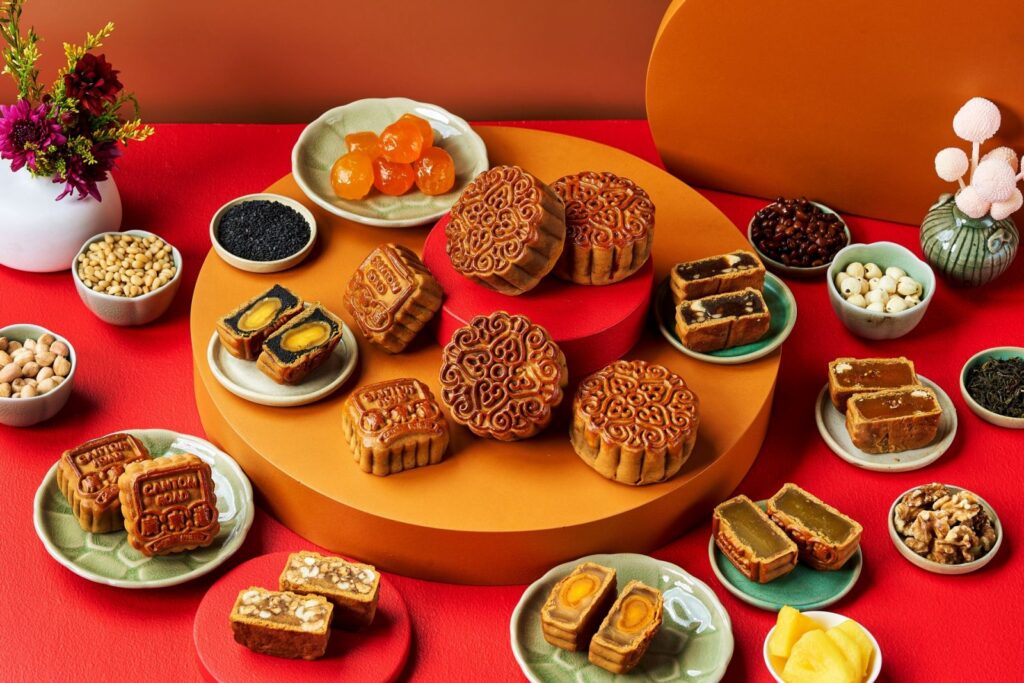
Hue Festival
The biennial Hue Festival, set in the imperial city of Hue, showcases the cultural legacy of Vietnam’s former capital. Traditional music, dance, and art performances, along with processions reenacting historical events, are hallmarks of this festival. Its purpose is to preserve and propagate the cultural treasures of the Nguyen Dynasty and bring history alive for both locals and visitors.
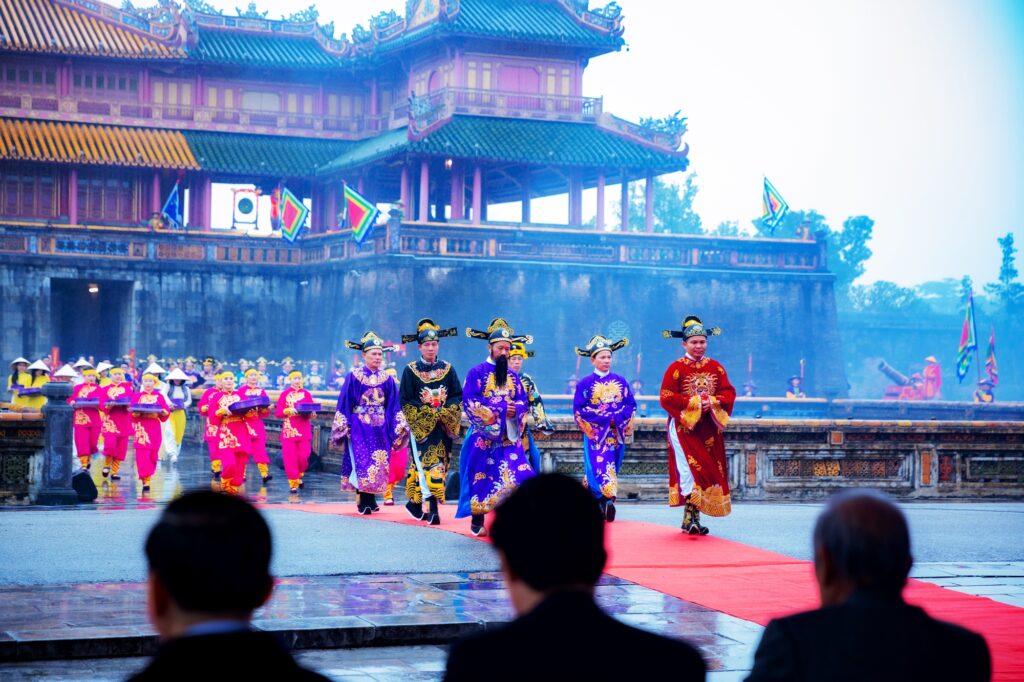
Hoi An Lantern Festival
The enchanting Hoi An Lantern Festival graces the ancient town of Hoi An each month. The town is adorned with a mesmerizing display of colorful lanterns, and visitors can float their own lanterns on the river, visit temples, and relish street performances. This celebration commemorates the town’s rich cultural heritage and its status as a UNESCO World Heritage site.
These festivals open a splendid window for foreign tourists to deeply immerse themselves in Vietnamese culture, engage with welcoming Vietnamese people, and partake in the warm-hearted festivities that define these cherished celebrations.
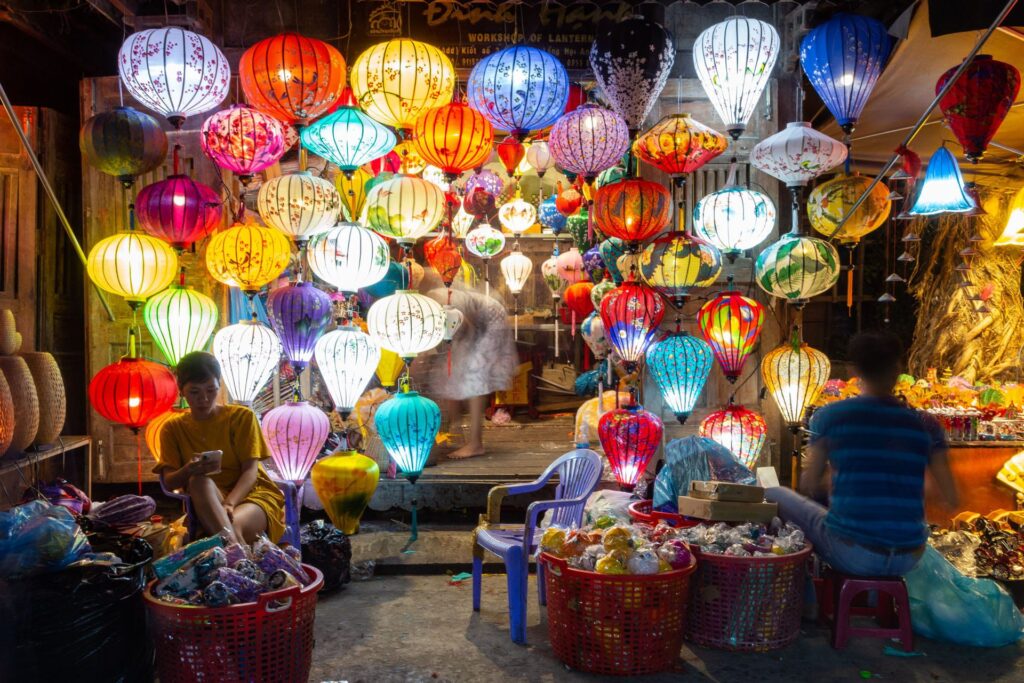
Clothing: Embracing Tradition Through Ao Dai
The Ao Dai, an iconic symbol of Vietnamese culture, is a graceful and timeless traditional outfit. This elegant attire consists of a long, flowing tunic paired with matching trousers and often complemented by a non la, a traditional conical hat. The Ao Dai’s design highlights its high side slits, which not only add to its visual allure but also allow for ease of movement. This attire, with its intricate details and vibrant colors, has become synonymous with the national identity and is worn by women of all ages. Its unique characteristics make it a standout piece of clothing that beautifully combines tradition with sophistication.
The Ao Dai is more than just a piece of clothing; it carries deep cultural significance in Vietnam. Many Vietnamese women wear Ao Dai on various occasions, from weddings and festivals to formal gatherings. The choice of color and design often reflects the nature of the event and the wearer’s age. Despite its long history, the Ao Dai has continued to evolve to suit modern tastes while preserving its cultural roots. It’s not uncommon to see contemporary adaptations of the Ao Dai for everyday wear, emphasizing its adaptability and enduring relevance. Whether in its traditional or modern form, the Ao Dai remains a symbol of pride for Vietnamese people and a blend between traditional and contemporary values.
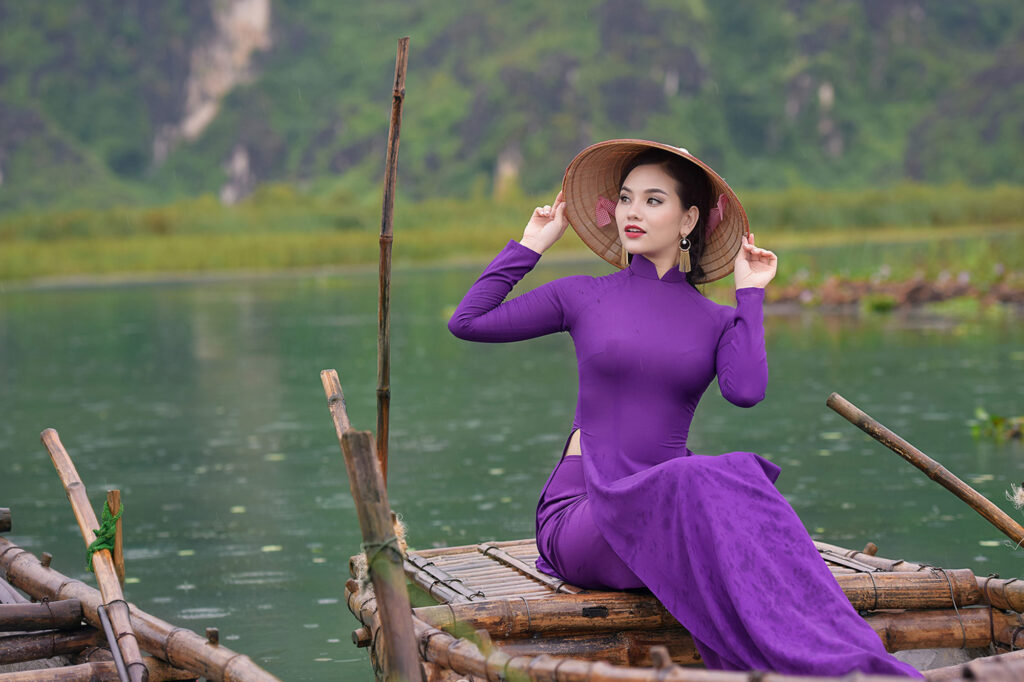
Customs and Traditions
Vietnam boasts a rich tapestry of customs and traditions deeply embedded in its history and cultural identity, offering a unique window into daily life and societal values.
1. Ancestor Worship
Ancestral veneration stands as a cornerstone of Vietnamese culture, underscoring the paramount importance of familial bonds and honoring one’s forebears. Vietnamese households often feature ancestral altars adorned with photographs and offerings such as fruits, incense, and flowers. Special occasions, like yearly ancestors death anniversaries or the Lunar New Year (Tet), prompt and joyful family reunion would pay respects to ancestors. Ancestor worship practice establishes a profound spiritual connection between the living and the deceased, ensuring their continued guidance and protection.

2. Communal Rituals
Community plays a pivotal role in Vietnamese culture, and communal rituals serve as an integral part of local life. Numerous villages hold annual festivals that commemorate local deities, agricultural milestones, or historical figures. These festivities entail elaborate offerings to the gods, traditional performances, and communal feasting. Communal rituals reinforce a sense of unity among villagers, fostering community cohesion and solidarity.
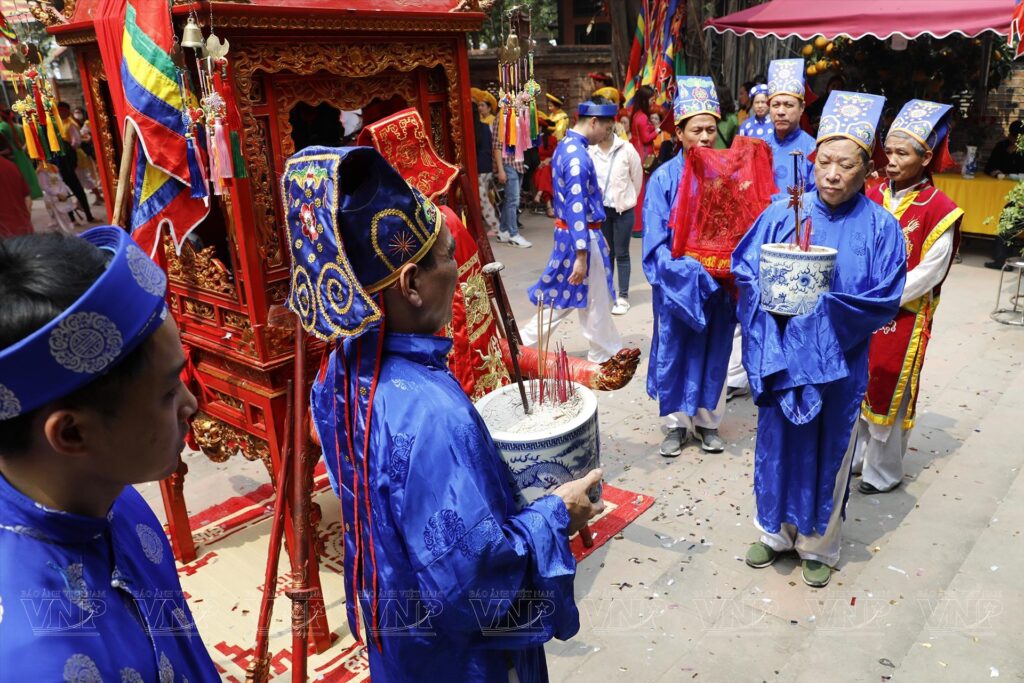
3. Vietnamese Wedding Ceremonies
Vietnamese wedding ceremony represent a beautiful amalgamation of tradition and modernity, reflecting the central significance of family and love. Traditional betrothal ceremonies involve formal introductions, gift exchanges, and the presentation of a dowry. During weddings, couples perform a meaningful tea ceremony to demonstrate respect to their parents and receive blessings. The color red, symbolizing love, happiness, and prosperity, and traditional Vietnamese songs also prominently feature in Vietnamese weddings.
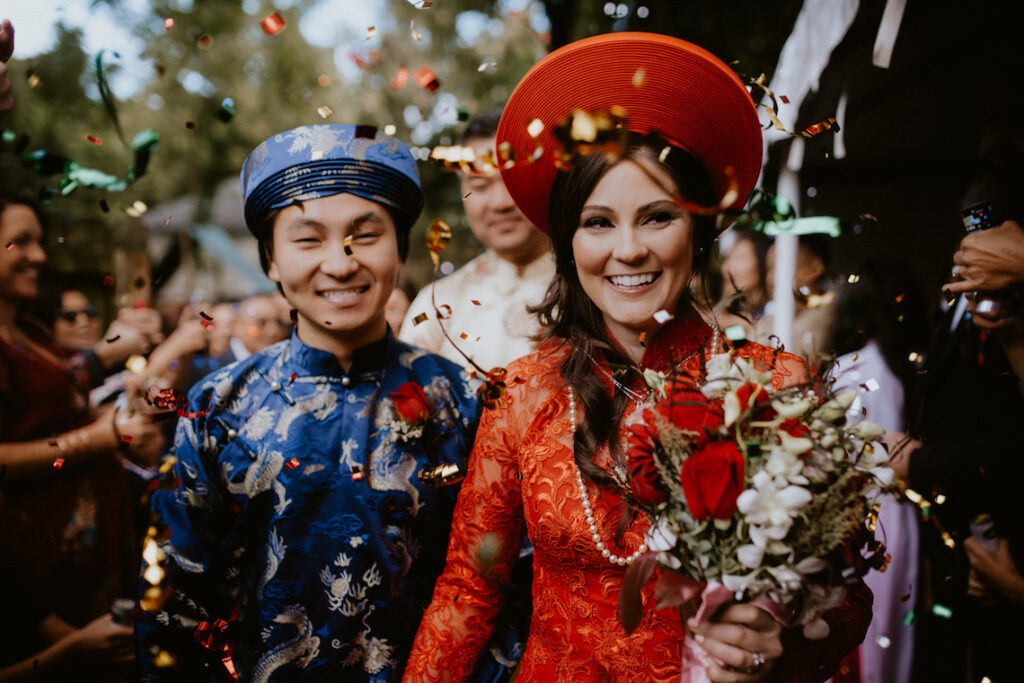
4. Spiritual Practices
Spirituality is a fundamental facet of Vietnamese society, influenced by a blend of Buddhism, Confucianism, Taoism, and indigenous beliefs. It’s recommend to explore the serene beauty of Vietnam’s pagodas and temples, which serve as places of worship and contemplation. You could learn about the monastic traditions and the vital role of monks and nuns in preserving spiritual heritage. Or discover the meditative practices that offer solace and spiritual growth to many Vietnamese, fostering a profound connection to their inner selves and the world around them.
Etiquette in Vietnam
Vietnamese etiquette is deeply intertwined with the country’s rich culture and traditions, and it plays a significant role in daily interactions. As a foreign tourist in Vietnam, understanding and respecting these Vietnamese traditions can greatly enhance your experience.
Greetings and Gestures
In Vietnam, greetings are typically accompanied by a slight bow and a friendly smile. Handshakes are also common in formal settings. When addressing others, especially elders, it’s customary to use titles and honorifics. For instance, “Anh” is used for older men, “Chi” for older women, and “Em” for younger individuals. While handshakes are generally acceptable, public displays of affection should be avoided, as they are considered inappropriate.
Respect for Elders
Respecting elders holds great importance in Vietnamese culture. It’s customary to let elders speak first and offer them the most comfortable seats. When giving or receiving something from an elder, it is polite to use both hands as a sign of respect. Disagreements should be handled with tact and respect, especially when dealing with older individuals.
Dining Etiquette
Dining etiquette in Vietnamese culture is a reflection of the country’s culinary heritage. If you are not comfortable using chopsticks, it’s advisable to learn or bring a fork. Avoid sticking chopsticks upright in a bowl of food, as it resembles incense sticks used in funerals. Contrary to Western norms, slurping noodles is not considered impolite; in fact, it signifies that you are enjoying the meal. When offering food or receiving a dish from someone, always use both hands to express gratitude.
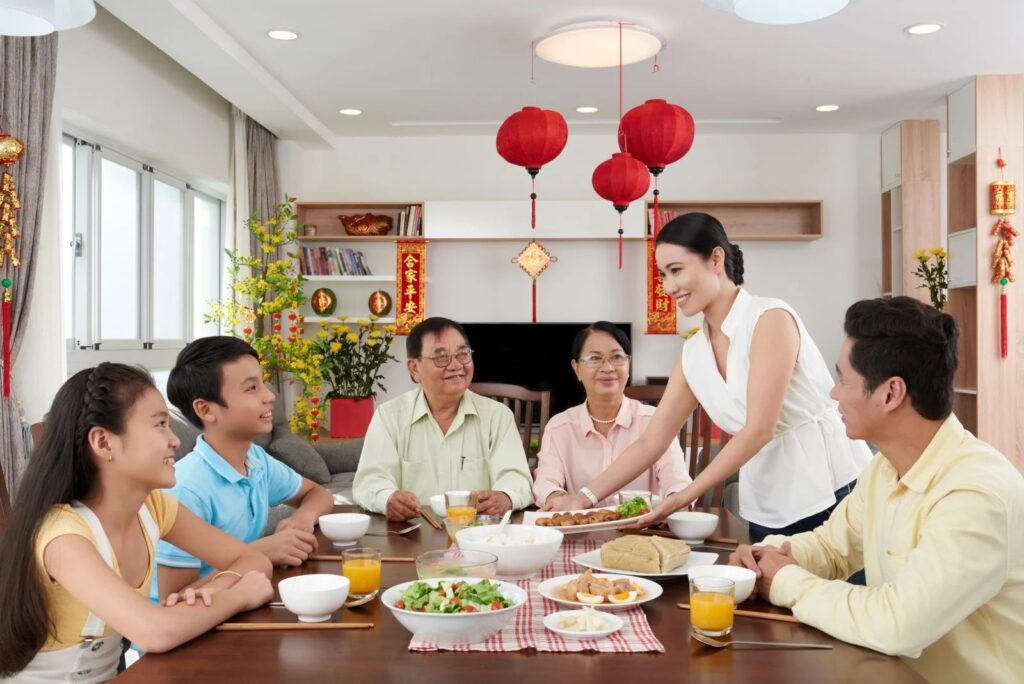
Removing Shoes – Iconic Vietnamese Etiquette
Different from the customs of Western countries, when entering Vietnamese people’s homes, it is customary to remove your shoes. Look for a designated area near the entrance for this purpose. The same rule applies when visiting temples and pagodas; always remove your shoes before stepping inside these sacred spaces.
Temple and Pagoda Etiquette
When visiting temples and pagodas, it’s essential to dress modestly. This means avoiding revealing clothing and opting for attire that covers your shoulders and knees as a sign of respect. Additionally, maintain a quiet and respectful demeanor within these sacred places, refraining from loud conversations and disruptive behavior.
Bargaining
Bargaining is a common practice in Vietnamese markets, but it should be done with respect and a friendly attitude. Avoid aggressive haggling, as it may be considered impolite.
Public Behavior in Vietnamese Culture
Public displays of affection should be kept private, as they may be offensive in public places. Be mindful of noise levels, especially in residential areas, as excessive noise is generally frowned upon.
Photography Etiquette
When taking photos of people, especially in rural or less touristy areas, always ask for permission. Additionally, respect privacy by refraining from taking pictures of sensitive or private areas, such as inside people’s homes.
Vietnamese Cuisine: A Culinary Adventure
Vietnamese cuisine offers a captivating journey through a diverse and delectable world of flavors. Iconic dishes like pho, a soul-warming noodle soup, spring rolls bursting with freshness, and banh mi sandwiches packed with unique ingredients are just the beginning of this culinary exploration. Each dish tells a story of Vietnam’s history and culture, with regional variations that add layers of depth to its gastronomic heritage.
Food in Vietnam is not merely sustenance; it’s a cultural tapestry reflecting the country’s rich diversity. With influences from Chinese, French, and Southeast Asian cuisines, Vietnamese dishes are a harmonious blend of flavors and ingredients. Meals are often seen as opportunities for families and communities to come together, fostering bonds and celebrations. As you journey through Vietnam, you’ll discover that each region has its own culinary treasures, offering a tantalizing glimpse into the country’s past and present.
Dining in Vietnam comes with its own set of customs and etiquette, including the use of chopsticks and the ritual of tea. Street food culture is a vibrant and unmissable part of the experience, where bustling markets and food stalls serve up authentic delicacies. Exploring food markets and participating in cooking classes are excellent ways for travelers to immerse themselves in the world of Vietnamese cuisine.
So, when you visit Vietnam, be prepared to embark on a flavorful adventure that will not only satisfy your taste buds but also deepen your appreciation of the country’s rich traditions and culture.
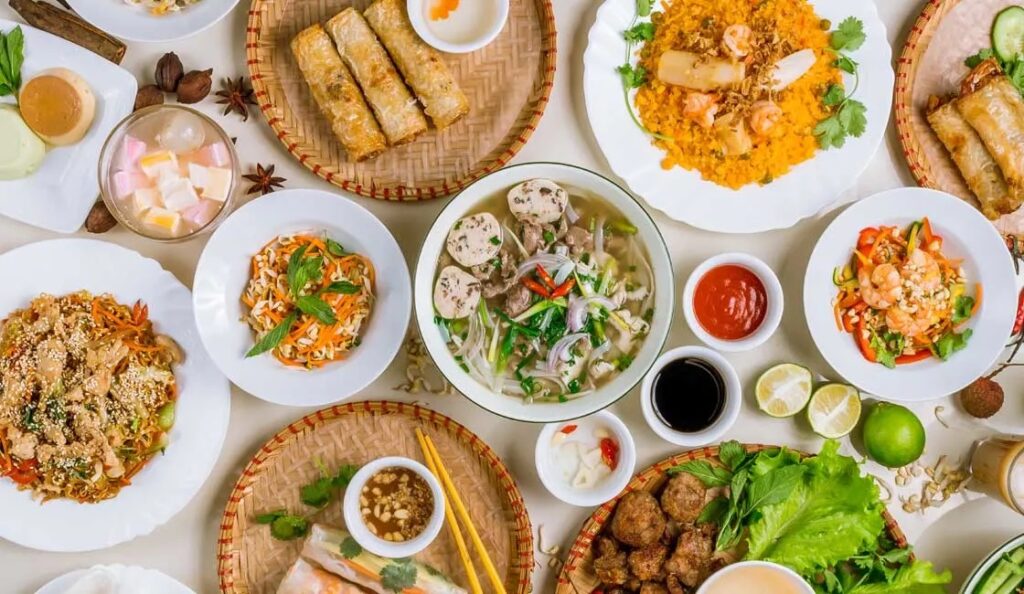
Conclusion
In closing, Vietnam’s cultural heritage is a vibrant tapestry woven from centuries of history, customs, and traditions. It is a nation where the past and present coexist harmoniously, shaping the lives of its people and providing a unique experience for visitors.
When visiting Vietnam, we encourage you to embrace and respect these traditions. Immerse yourself in the festivities of Tet, savor the flavors of Vietnamese cuisine, and engage in the time-honored customs that have been passed down through generations. By doing so, you’ll not only gain a deeper appreciation for this beautiful country but also create meaningful connections with its warm and welcoming people.
Remember that understanding and respecting local traditions is not only a sign of cultural appreciation but also a bridge that fosters a more enriching and memorable travel experience. So, as you embark on your memorable trip through Vietnam, let its traditions become a source of inspiration and a window into the soul of this remarkable nation.
Plan your hassle-free trip to Vietnam with e-Visa!
Let our extensive 10+ years of experience in visa services be your guiding light as you book with us, guaranteeing a smooth and worry-free trip to Vietnam!





